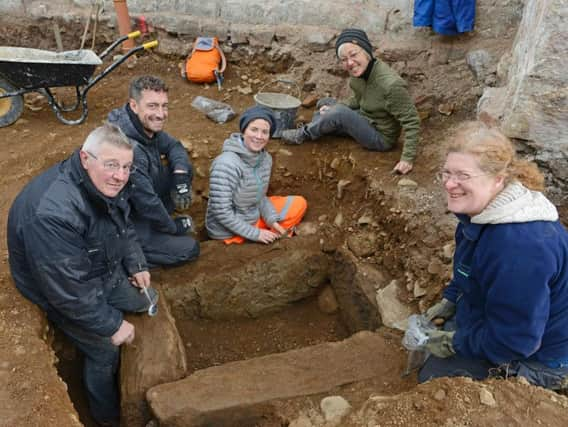VIDEO: 4,000-year-old human bones found in Wooler


Digger driver Steven Turtle was laying drainage pipes on Friday when he struck what turned out to be the cover of a Bronze Age cist, or chest.Inside were human remains in a crouched burial position.Local archaeologist Roger Miket said: “We are looking through a tiny pinhole of history but it’s probably fair to say we have discovered Wooler’s oldest inhabitant.“We are looking at a date from 2200BC to about 1750BC, the start of the Bronze Age known as the beaker period where things that were useful for the afterlife such as food and drink were put in the grave.“To put that timeframe into perspective, it’s the distance that separates us from Julius Caesar as far back again.“Sometimes, the graves had a beaker in them but in this case it doesn’t and sometimes the body is clothed and we don’t know the answer to that yet.“It may have been a woman because they were buried on their right side with their head to the west, although we can’t be certain until further analysis is done.“It also seems to have been charred so that is an interesting insight into the burial process.“Of course, we have no idea of their religious beliefs but we have the symbols which give us some idea of what they thought so we know they believed in the afterlife.Alnwick-based builder Ivor Jones put work to convert a stable block into holiday cottages on hold while the find was properly investigated by Northumberland County Council archaeologists Karen Derham and Sarah Winlow.“It was a surprise discovery so it’s pleasing that the council were able to respond so quickly to what’s been found,” said Mr Miket. “Ivor Jones has been fantastic too.”He added: “Work will now be done in the labs to look at the bones and teeth to find out how old they were and possible illnesses.“We hope it will provide an additional insight into what we know about that period.“It’s also important to remember that this little box is not just an archaeological diary of this person’s last days. It may be precious from an archaeological view but the last time before we came across it, people were feeling grief and sadness.”Charlotte Lowery, hotel manager, said: “It’s been a very exciting few days here. It’s an amazing discovery.“We’re having six self-contained holiday cottages built and the builders were just laying the last drain and came across a very flat, large stone and it became apparent it shouldn’t have been there.“On further investigation they found this – human remains – so the police were called. They cordoned off the area but it quickly became apparent that no one was going to get into trouble.“Archaeologists were then called and they immediately knew these were very old bones. They have worked so hard to uncover this.A council spokesman said: “The council’s archaeology team was alerted to this discovery last Friday, and is on site supporting the recovery of a Bronze Age cist, and checking to make sure that there are no associated remains. “This was discovered by the developer when digging service trenches for new buildings on the site.”The Wooler area contains numerous archaeologically important sites from prehistoric cup and ring motifs carved into sandstone outcrops, henges and strategically sited hillforts including Ad Gedfrin, the palace of the ancient kings of Northumbria.